QSDA2021 Qlik Sense Data Architect Certification Exam - February 2021 Release Free Practice Exam Questions (2025 Updated)
Prepare effectively for your Qlik QSDA2021 Qlik Sense Data Architect Certification Exam - February 2021 Release certification with our extensive collection of free, high-quality practice questions. Each question is designed to mirror the actual exam format and objectives, complete with comprehensive answers and detailed explanations. Our materials are regularly updated for 2025, ensuring you have the most current resources to build confidence and succeed on your first attempt.
Refer to the exhibit.
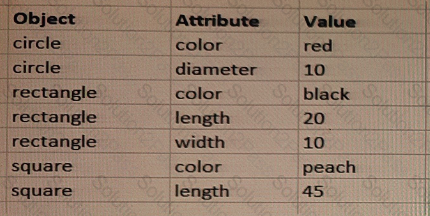
While performing a data load from the source shown, the data architect notices it is NOT appropriate for the required analysis.
The data architect runs the following script to resolve this issue:

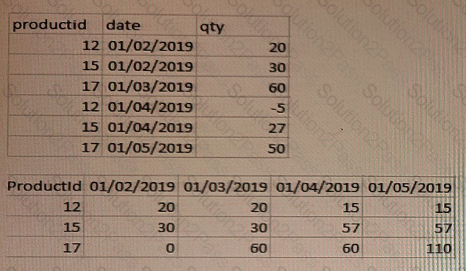
Refer to the exhibits.
The first table shows the source table (Original table).
This data represents the stocks stored every month for each product:
• The relevant fields are productid, qty, and date.
• The date field represents the calendar months using
• The qty field shows the product stock fluctuation from the current month versus the previous month. If there is no fluctuation between months, there are no new entries in the table.
The second table shows a Pivot table visualization the data analyst needs to create in the app displaying per each product the monthly trend of available stock.
For performance reasons, the data analyst requests the data architect to calculate the running stock quantity of each product for every month in the script.
Which approach should the data architect use?
Refer to the exhibit.
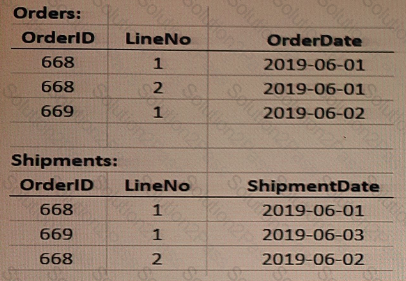
A data architect is loading the tables and a synth key is generated.
How should the data architect resolve the synthetic key?
A data architect needs to upload data from ten different sources, but only if there are any changes after the last reload When data is updated, a new file is placed into a folder mapped to E A439926003 The data connection points to this folder.
The data architect plans a script which will:
1.Verify that the file exists
2. If the file exists, upload it Otherwise, skip to the next piece of code
The script will repeat this subroutine for each source. When the script ends, all uploaded files will be removed with a batch procedure.
Which option should the data architect use to meet these requirements?
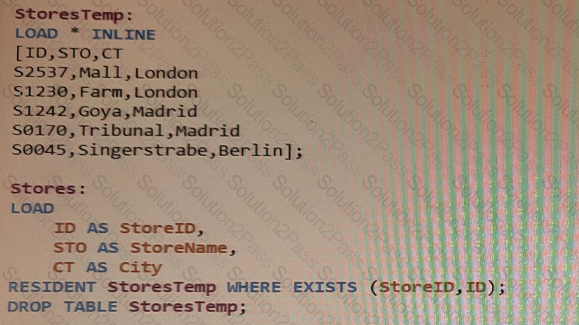
Refer to the exhibit
A data architect develops an app for Coffee4all, a coffee company with stores located throughout Europe
The script runs successfully, but the Stores table does not have any values.
What should the data architect do?
A data architect needs to load data from two different databases Additional data will be added from a folder that contains QVDs. text files, and Excel files.
What is the minimum number of data connections required?
Refer to the exhibit.
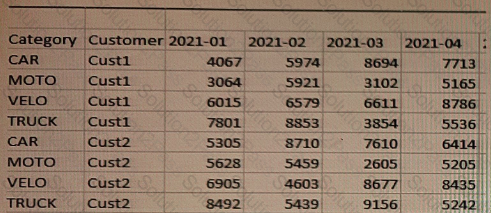
A customer needs to load forecast data from an Excel file.
Which preceding load statement should the data architect use to load the data?
A)

B)

C)

D)

Refer to the exhibit.

A data architect needs to add a Budget table to the current Qlik Sense app. A Budget table with the fields Budget, CustomerlD, and ProductlD is loaded into the model. What will be created?
Refer to the exhibits.
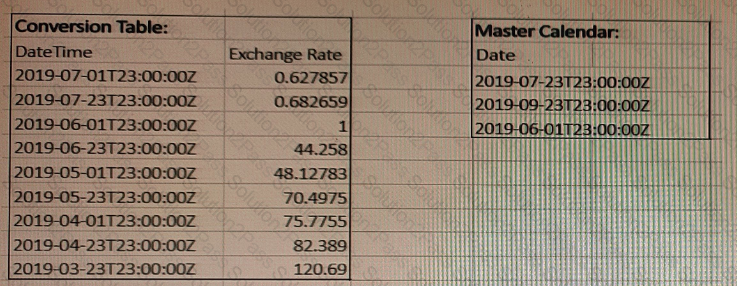
A business analyst needs to see the currency conversion provided by a third party process, and only contains a record when the rate changes in a chart. The currency conversion rate data is
An existing master calendar exists in the datamodel that contains a full set of dates.
Which technique should the data architectuse to meet this requirement?
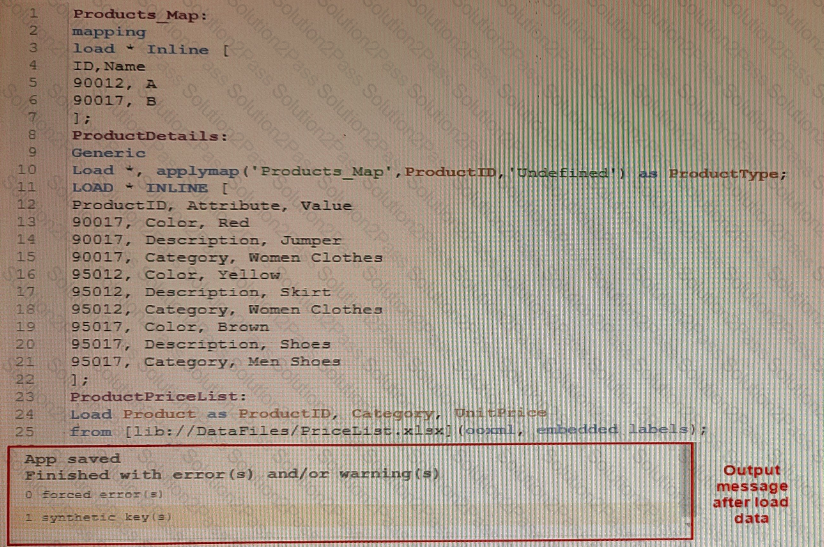
A data architect is creating an app using three tables. After executing the script, a warning displays
Which two steps should the data architect do to resolve this warning? (Select two.)
Refer to the exhibit.

A data architect is working on a Qlik Sense app the business has created to analyze the company orders and shipments. To understand the table structure, the business has given the following summary:
• Every order creates a unique orderlD and an order date in the Orders table
• An order can contain one or more order lines one for each product ID in the order details table
• Products in the order are shipped (shipment date) as soon as tliey are ready and can be shipped separately
• The dates need to be analyzed separately by Year Month, and Quarter
The data architect realizes the data model has issues that must be fixed.
Which steps should the data architect perform?
A data architect needs to develop a script to export tables from a model based upon rules from an independent file. The structure of the text file with the export rules is as follows:

These rules govern which table in the model to export, what the target root filename should be, and the number of copies to export.
The TableToExport values are already verified to exist in the model.
In addition, the format will always be QVD, and the copies will be incrementally numbered.
For example, the Customer table would be exported as:
What is the minimum set of scripting strategies the data architect must use?
A data architect wants to combine data on presentand historic sales performance.The historic data is stored in a de-normalized archive, and the present data is maintained in a database. The output must be contained in a single table.
Which script should the data architect use?
A)

B)
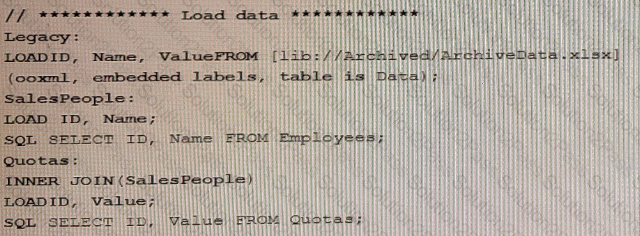
C)
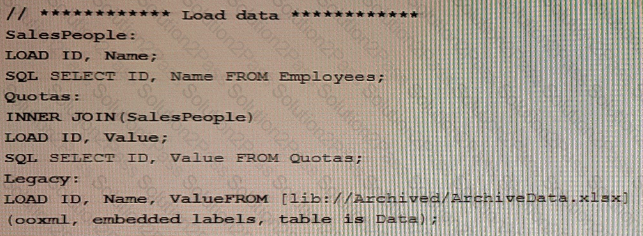
D)
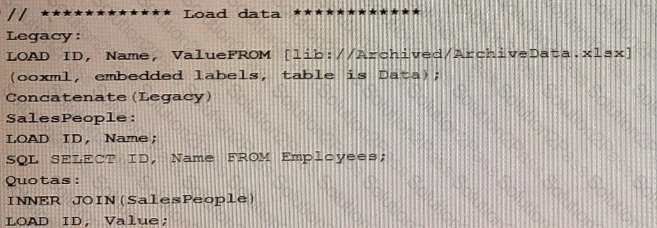

Refer to the exhibit
A data architect is working on an app that contains orders, invoices, and shipping data. There are three different date fields within the data:
* OrderDate
* InvoiceDate
* ShippingDate
The business analyst needs to replicate the chart above to show Order and Shipping amounts on the same Month axis.
What should the data architect do?
Refer to the exhibit.

A data architect is working with an app and creates some visualizations to check the data. Some visualizations show issues in the data set.
*The Sales by Country table shows a total OrderValue of18,300 sales while the KPI shows a total OrderValue of 20,600.
*The Sales monthly trend bar chart does not work with the Month field.
Which two data issues should the data architect fix in the app? (Select two.)
